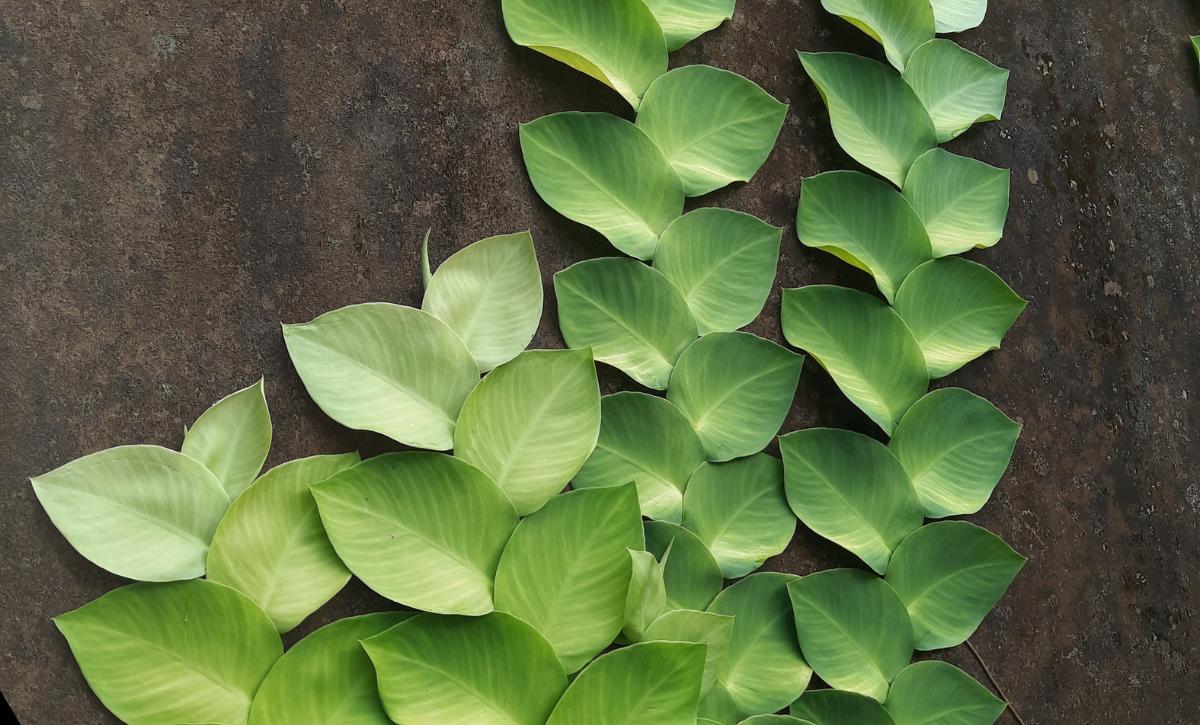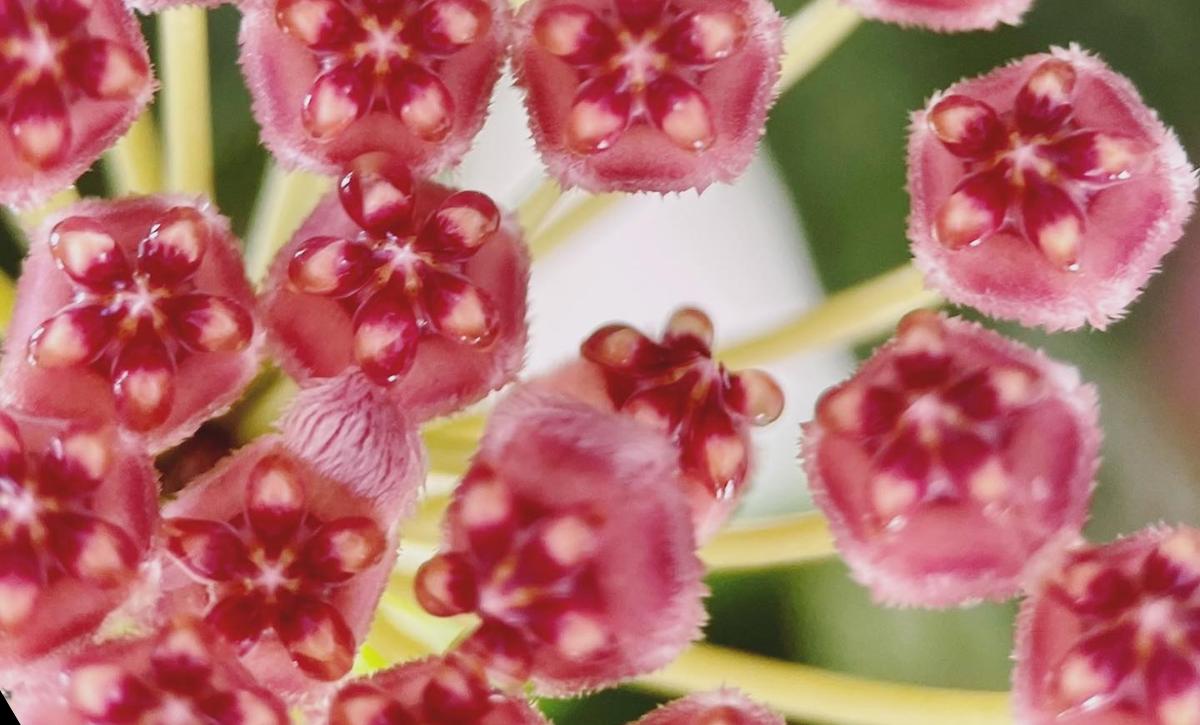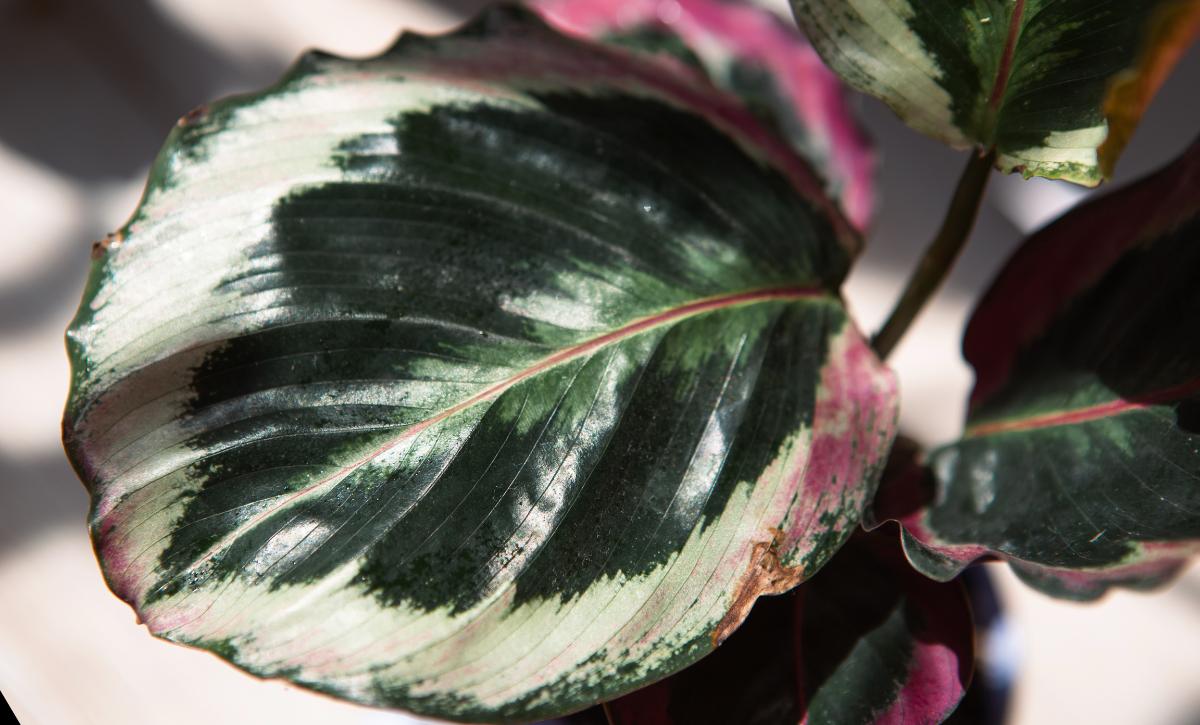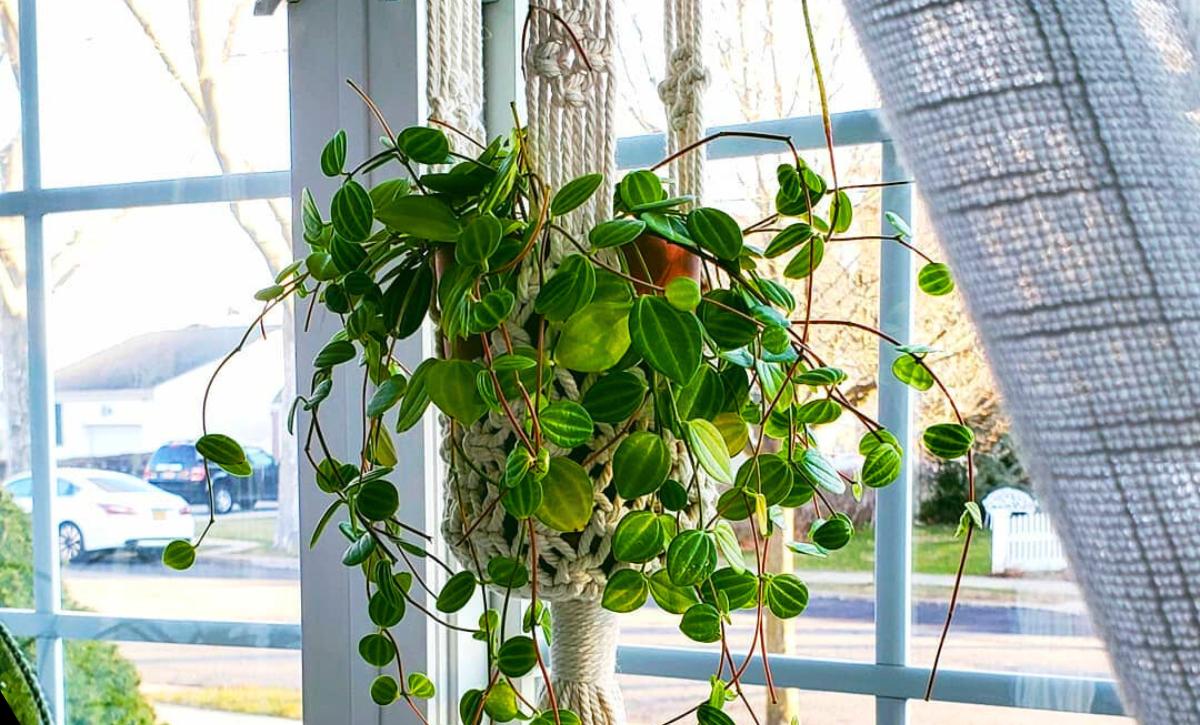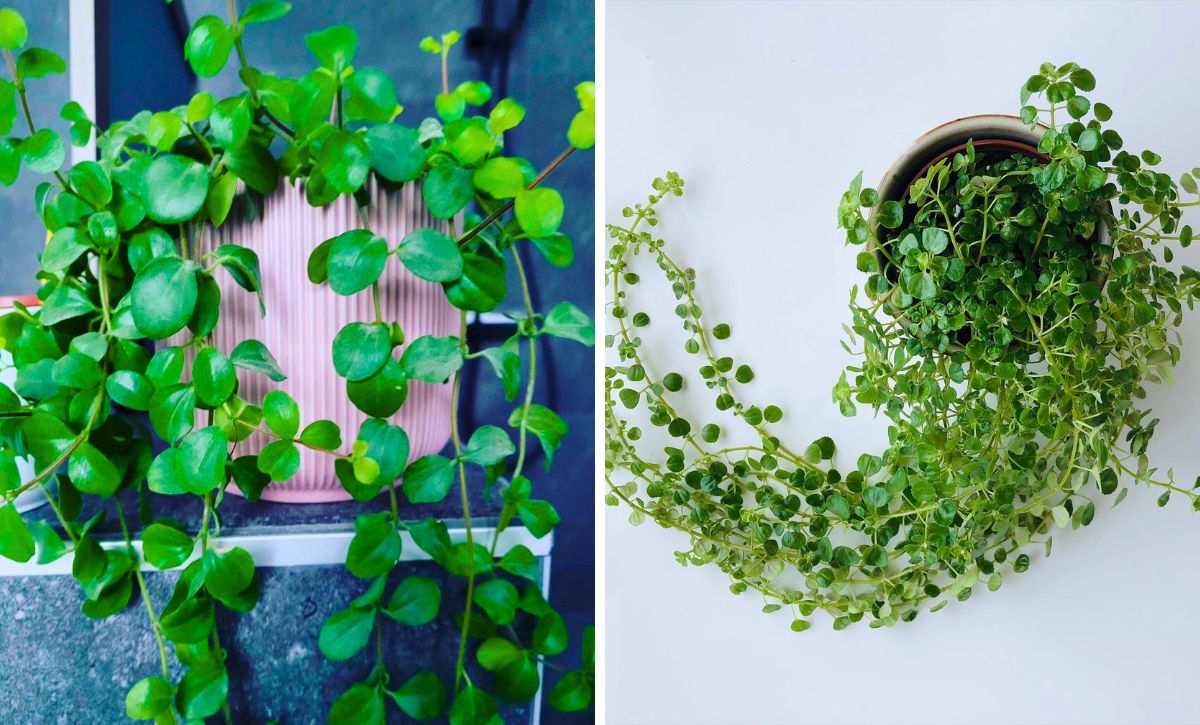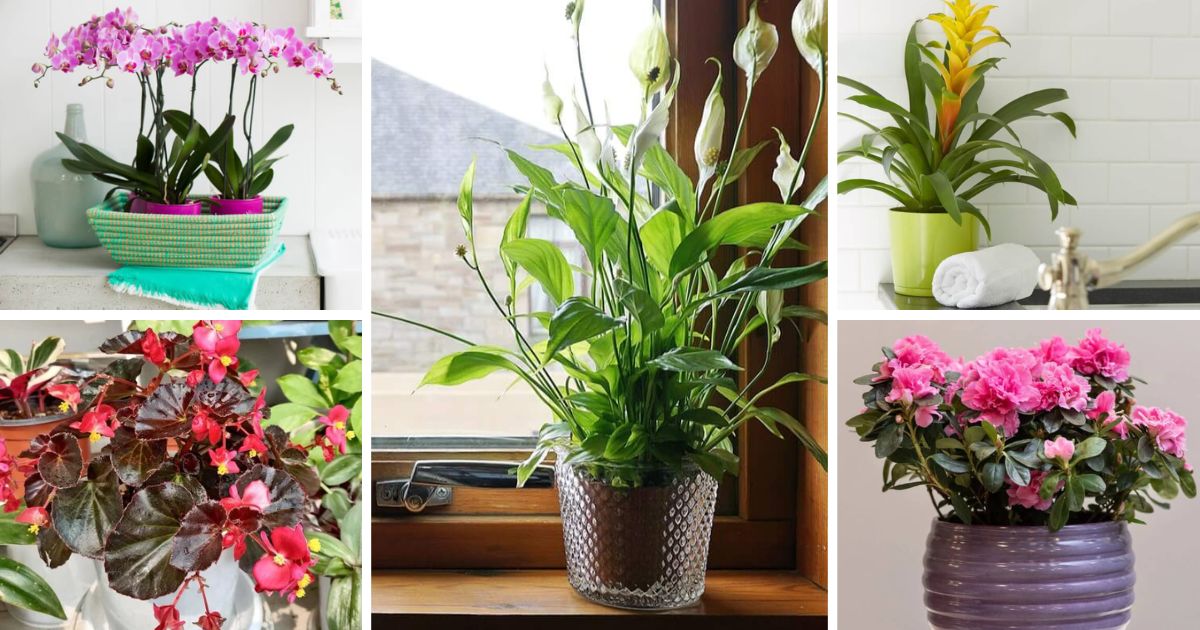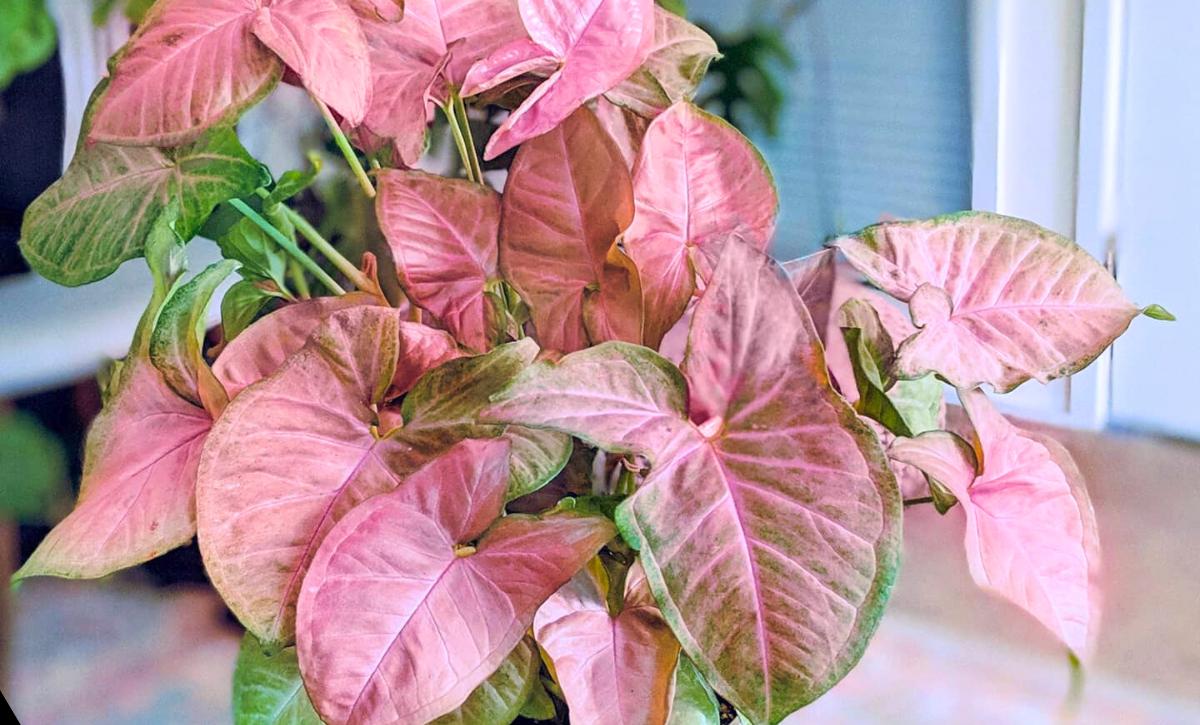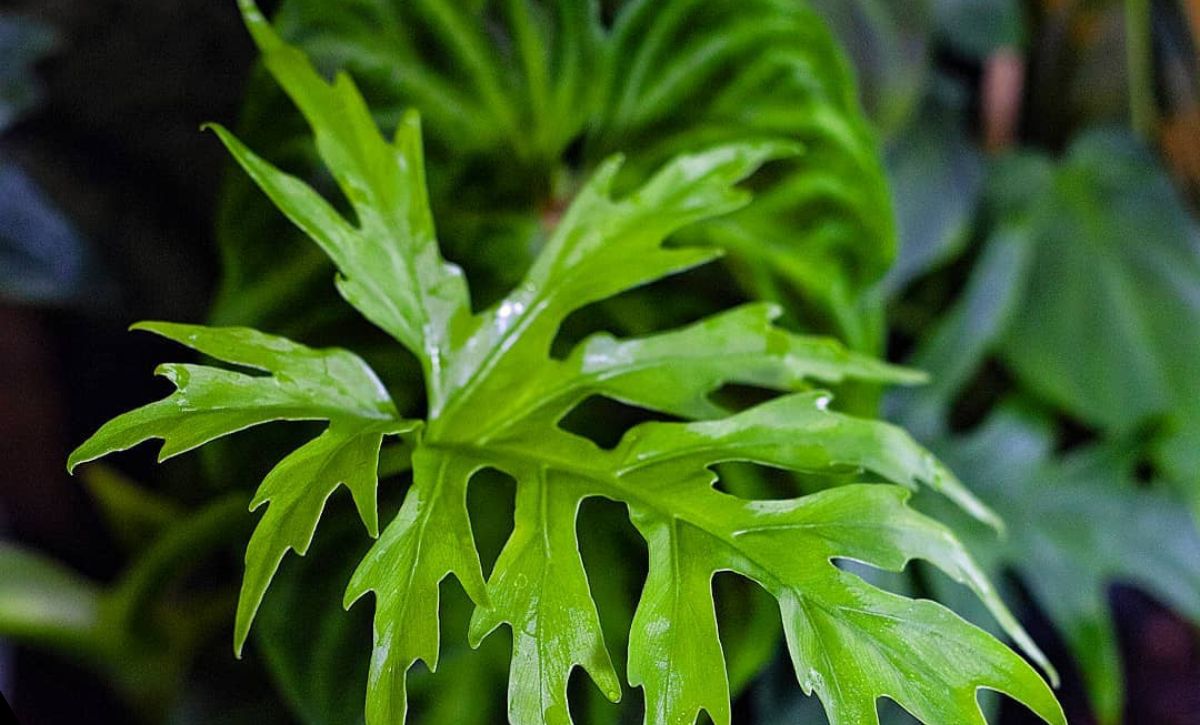You have a small room with little to no light, a lonely corner, or even a dark office, but you yearn to light up the space with blooming green plants. Well, here’s a solution!
Look for some hanging baskets and search for plants that thrive with little light or no sunlight. Within no time, you will have created an oasis in your dark-lit space.
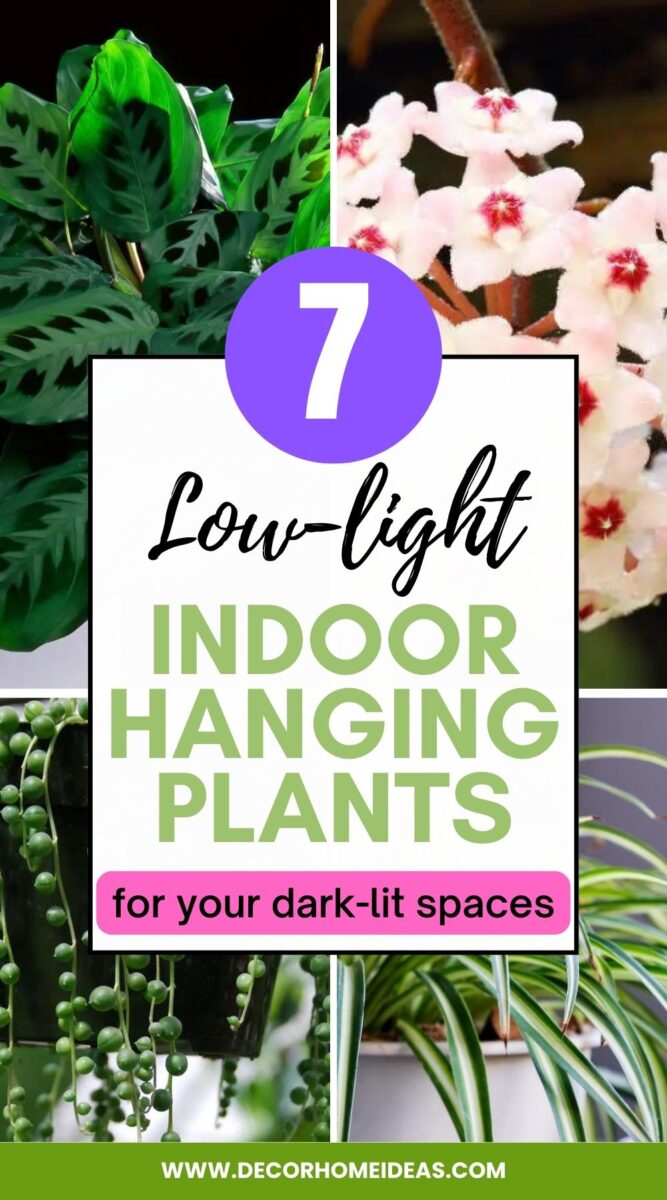
Many varieties of low-light indoor hanging plants, including Marble Queen Pothos, Spider Plant, English Ivy, and Prayer Plant, would add natural beauty to your shelves, fireplaces, ladders, and cabinets.
In this article, we’ll discuss seven varieties of low-light indoor hanging plants that you can easily add to your home. The article will serve as a guide to all the requirements required for your low-light plants to thrive. We hope you enjoy it!
7 Low-Light Indoor Hanging Plants
The lack of light in rooms is a common problem for many indoor spaces. Many species of plants require sunlight, but there are some exceptions.
Also, when choosing your hanging baskets for plants, you should go for trailing vines and stems, draping foliage, and even arching fronds or branches for an incredible cascading effect.
Luckily, many plants have these characteristics and can change your interior decor into a lush oasis.
Let’s take a look at some of them!
1. Marble Queen Pothos
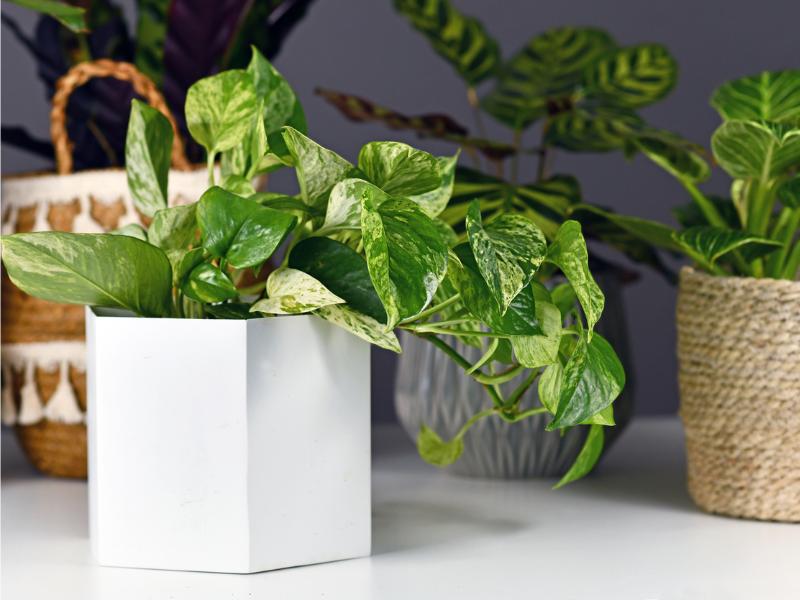
Pothos is a widespread species of plant used worldwide for interior decorating. Also known by its scientific name, Epipremnum Aureum, the marble queen pothos is a simple-maintenance plant that you won’t have to struggle with too much.
Native to the Islands of French Polynesia, this plant measures approximately 10 feet (3m) long. Marble queen pothos has a slow growth rate and is also toxic.
Here is some additional information regarding this plant:
Appearance
The plant has bright green leaves blotched with creamy or white variegations, depending on the cultivar and the plant.
Light Requirements
Marble queen pothos requires bright or medium indirect light but can adapt to low-lit spaces. This makes it an ideal plant for beginners.
By the way, when we talk about “moderate” or “medium” indirect light, it means the room only gets reflected light from adjacent walls, not necessarily low light.
Low light means spaces where your plants won’t receive much sunlight, especially during daytime.
Keeping your pothos plant away from direct light would be best since it can hurt its colorful and delicate foliage.
Water and Humidity
This pothos plant doesn’t require too much water. When the top soil is dry, you should moderately water the plant, letting excess water drain through the potholes.
Marble queen can survive in average home humidity but thrives in places with a humidity of around 60%. You can buy a hygrometer from your local store and measure your humidity, just to be sure.
Temperature
This plant thrives in temperatures between 18 and 29℃ (65-85℉). Placing the plant in spaces with a temperature below 13℃ (55℉) will have dire repercussions.
Soil and Fertilizer
Marble queen pothos flourishes in fertile soil rich in organic matter and nutrients. The soil needs to be well-drained and aerated to avoid any incidences of fungal diseases and overwatering.
Fertilizer is not really necessary with this pothos plant, especially when using fertile soil like loam. Nonetheless, if you’re using low-nutrient soil, you should add a well-balanced and diluted fertilizer once a month.
2. Spider Plant
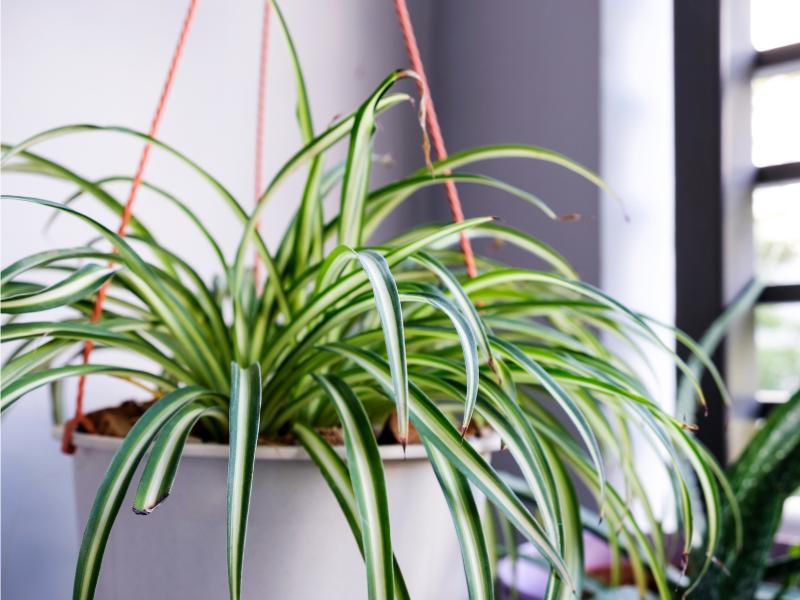
Just like its name, the spider plant boasts leaves that resemble spiders. The scientific name for the plant is Chlorophytum comosum, and it is native to the South African tropical forests.
Spider plant has a fast-growth rate, reaching a height of 30-60 cm (1-2 feet). The plant is also non-toxic.
Appearance
The spider plant has long, arching, blade-like, and mottled leaves. The leaves are bright to mid-green and in shades of cream.
The tips of the plant’s stems are adorned by little pups which drape your baskets, trying to climb down. The plant also blooms with small white and star-shaped flowers.
Light Requirements
Even though spider plants do well in low light spaces, they usually require bright light. Lack of enough sunlight will make them lose their beautiful white lines. On the flip side, having a completely green spider plant is a bonus and very rare.
Water and Humidity
The spider plant is easy to maintain and only needs to be watered once a week. No special care is needed; water the plant when the topsoil is dry.
With regards to humidity, spider plants thrive in higher-humidity areas. However, they will also tolerate moderately humid spaces. There’s no need for you to go through the trouble of getting a humidifier.
Temperature
Usually, your thermostat should be set between 21 and 32℃ (70-90℉). However, spider plants can also thrive in much lower temperatures, including 2℃ (35℉).
Their growth at such temperatures is minimal, and the slow growth-rate begins when the temperatures drop below 18℃ (65℉).
Soil and Fertilizer
Spider plants can be grown in a variety of soils. The soils need only be well-drained and nutrient-rich to achieve optimal growth of the plants.
These plants are not selective when it comes to fertilizers. Any all-purpose houseplant fertilizer would be ideal: be it undiluted, diluted, granular, or liquid. You should avoid over-fertilizing and remember to always follow the instructions in the manual.
3. English Ivy
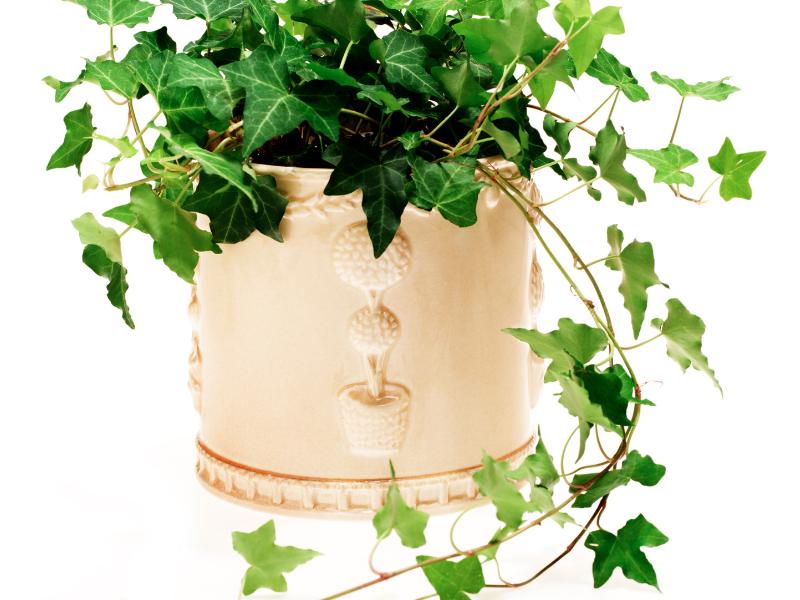
English ivy is the perfect indoor plant to dramatically affect your interior decor. It is a very low-maintenance plant with shiny effects and a cascade of refreshing leaves.
This plant is native to Western Asia and Europe and is also toxic. English ivy can grow up to 4.5m (15 feet) long or more, with a moderate to fast growth rate, depending on the conditions. Its scientific name is Hedera Helix.
Appearance
The plant’s leaves resemble small pears and normally have three to five glossy lobes. The leaves are dark green, with the upper part slightly darker than the bottom.
Light Requirements
If there was such a thing as perfect indoor hanging plants, then English ivy would be among the top ones. This plant can flourish in both full shade and full sun, eliminating the need for artificial lights.
Its tolerance for low-light spaces means its maintenance becomes even easier.
Water and Humidity
Even though the plant doesn’t need too much water, it still prefers moist soil. You should make sure the top soil is dry before watering it. Excess water should be drained; never allow the roots to sit in water.
English ivy loves humidity. As such, keep it at 45% or higher. Luckily, there are other alternatives you can use, such as moisturizing the air around your plant using a pebble tray or misting your plant.
Temperature
English ivy flourishes in temperatures between 18 and 29℃ (65-85℉). Temperatures higher than 32℃ (90℉) will result in stunted growth for the plant.
Soil and Fertilizer
The plant thrives in well-aerated and fertile soils, especially loamy soil.
You can add a well-balanced organic fertilizer to the plant twice a month when growing.
4. Prayer Plant
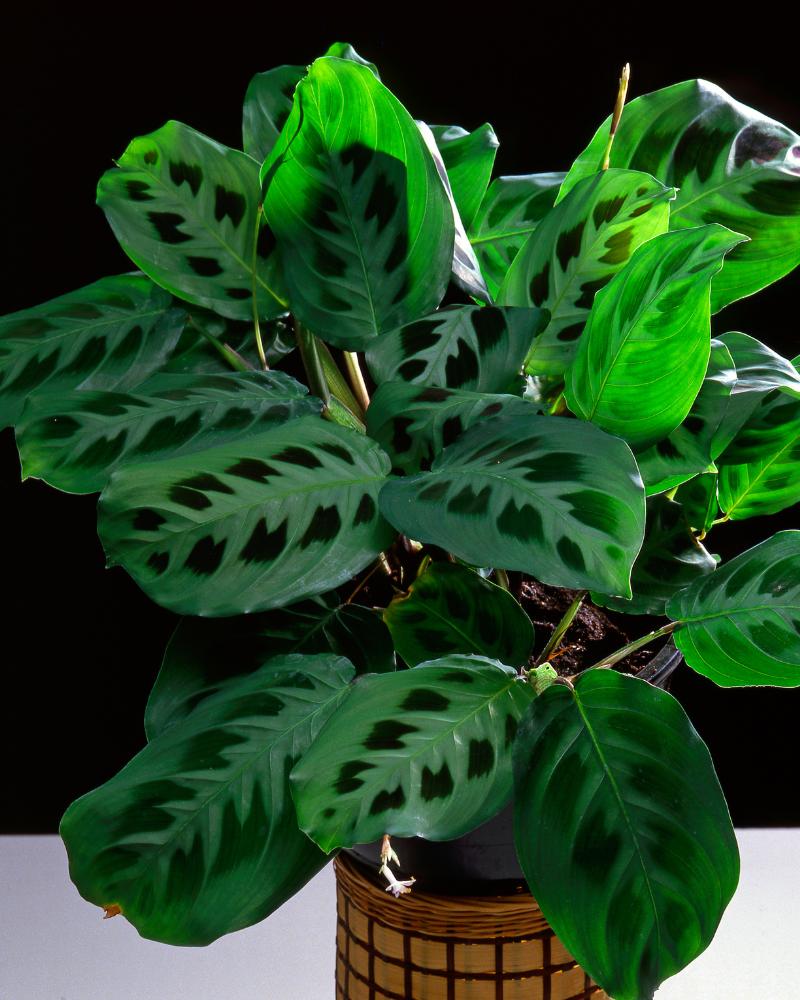
If you want an exotic, sumptuous and broad-leaved houseplant for a hanging basket in a low-lit space, take a look at the prayer plant.
The prayer plant’s scientific name is Maranta leuconeura, and it is native to the tropical forests of Brazil. The plant is non-toxic and a slow grower. It can grow up to 25-30 cm (10-12 inches) tall and 28-45 cm (15-18 inches) wide.
Appearance
The plant has wide, dark green foliage. A light green or white line runs down the middle of its oval-shaped leaves.
The branch’s veins sprouting from the spine are normally red, enclosing the whole underside of the leaf.
Light Requirements
The prayer plant needs bright or medium light conditions, and despite tolerating low light levels, it will lose some of its colorings.
Nonetheless, the plant still looks immaculate with its shades of green, and you can rarely miss the red veins.
Water and Humidity
The prayer plant loves moist soil, and you should water it once the top inch of soil is dry. Depending on humidity levels and air temperature during summertime, you might have to water the plant twice a week.
The plant flourishes in moderate humidity, even though some species may need humidity levels of around 60%. Still, there’s always the option of applying mist from time to time to ensure they are fine.
Temperature
The plant does well at room temperature, with anything between 18-27℃ (65-80℉) being ideal. If the temperature rises above 18℃, you should increase air humidity.
The prayer plant dislikes sudden temperature changes, with anything lower than 13℃ (55℉) resulting in stunted growth.
Soil and Fertilizer
This plant doesn’t need any special care with its medium. The soil needs only be moisture-retentive and well-draining. A good option is mixing loamy soil with peat moss and perlite.
You should apply fertilizer twice a month as the plant grows and once a month during its dormancy period. Dilute a balanced houseplant fertilizer to half-strength and apply it after watering.
5. Hoya
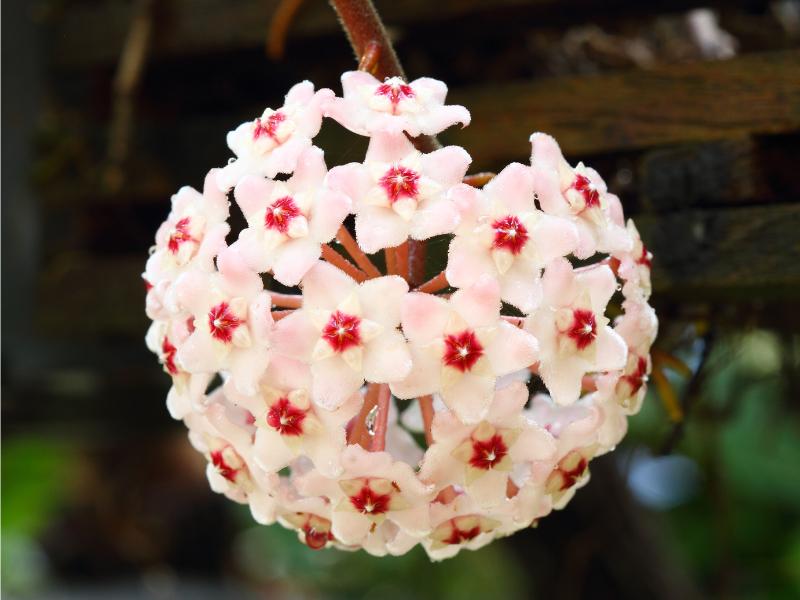
Hoyas are some of the best indoor plants that will leave your guests in awe. They come in different varieties, and you can choose which one is ideal for your home.
Hoya is a non-toxic plant native to Southeast Asia and Australia. Each species has a different growth rate, and they can grow up to 3.6 to 6m (12-20 feet) in their native habitat.
Appearance
Each species of hoya has its own unique appearance. Some are fuzzy, others are matte or glossy, while others have thick leaves.
This is also the case with their color. You may find varieties with white, yellow, pink, lilac, or red flowers which can invigorate your space in ways you couldn’t imagine.
Light Requirements
These plants flourish in medium light levels. Still, they do well in low light spaces. The only thing that affects hoyas is direct sunlight.
You can expose the plants to direct morning sunlight, but leaving them in the light for more than two hours will burn the plant’s foliage.
Water and Humidity
As it grows, you should water it regularly and always check if the topsoil is completely dry before watering. During fall and winter, hoyas enter dormancy and don’t require that much water.
Hoyas flourish in spaces with moderate humidity. You can invest in a humidifier, use the pebble tray method, or mist the plant to achieve the right humidity for this plant.
Temperature
These plants thrive at room temperature, with the ideal temperature between 15 and 29℃ (60-85℉). The plants will cease growing if temperatures fall below 13℃ (55℉).
Soil and Fertilizer
Hoyas require a well-draining and fertile medium with great aeration for optimal growth. The soil should also be able to retain some water, but you shouldn’t allow it to be soaking wet.
You can apply an all-purpose, mild fertilizer once a month to the plant. The fertilizer should be diluted to half-strength, and you should always water the plant first during application to avoid fertilizer burn.
6. Heartleaf Philodendron
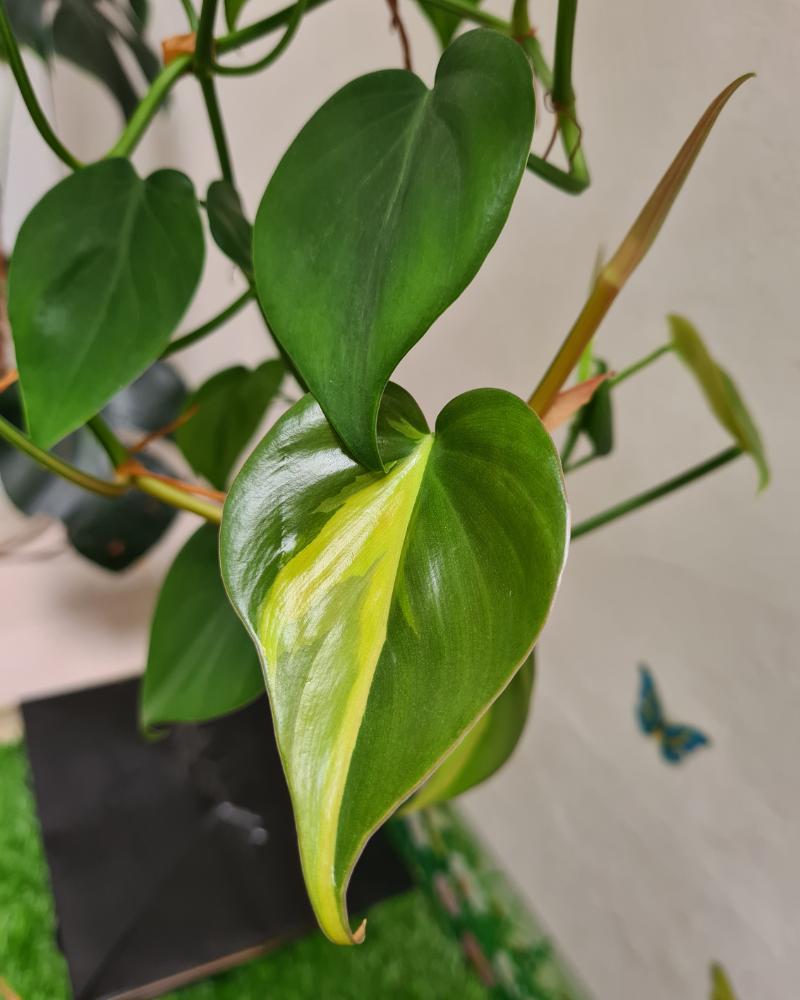
Suppose you love long trailing plants with beautiful showy and shaped foliage. In that case, the shade-loving heartleaf philodendron will surely impress you.
Also known by its scientific name, Philodendron hederaceum, this exotic plant from Mexico, the Caribbean, and Central and South America is 30-91 cm (12-36 inches) wide and 15-91 cm (6-36 inches) tall when grown indoors.
Heartleaf philodendron is a fast grower, and it’s also toxic.
Appearance
The plant’s main features are its heart-shaped or arrow-like leaves. It is also referred to as the arrowhead plant.
The color of leaves can differ from different species, and some plants may have slightly elongated leaves. Still, the basic heart shape is a constant to every plant.
Light Requirements
Since philodendrons are tropical plants, they need bright light conditions to thrive. Nevertheless, they can do well in low light levels, giving you numerous options for where to place them.
You should never place the plant in an area with direct sunlight since there’s a potential it will get burnt. You can expose the plant to morning sunlight for a few hours, though.
Water and Humidity
Heartleaf Philodendron doesn’t need too much water, and you should water the plant once the top few inches of the soil are dry.
The plant is an aroid and prefers places with high humidity levels. Your home’s humidity level should be above 60% to help the plant’s growth.
Temperature
Heartleaf philodendron thrives in temperatures between 21 and 27℃ (10-80℉). Temperatures below 13℃ (55℉) can cause stunted growth and irreparable damage.
Soil and Fertilizer
Heartleaf philodendron prefers well-drained aerated soil. Peat moss in the mixture will be useful since the plant loves moist soil. However, avoid clogging it with water since it can lead to root rot.
You can apply a diluted general-purpose fertilizer once a month, but ensure you dilute it with enough water to avoid damage to the plant.
7. String of Pearls
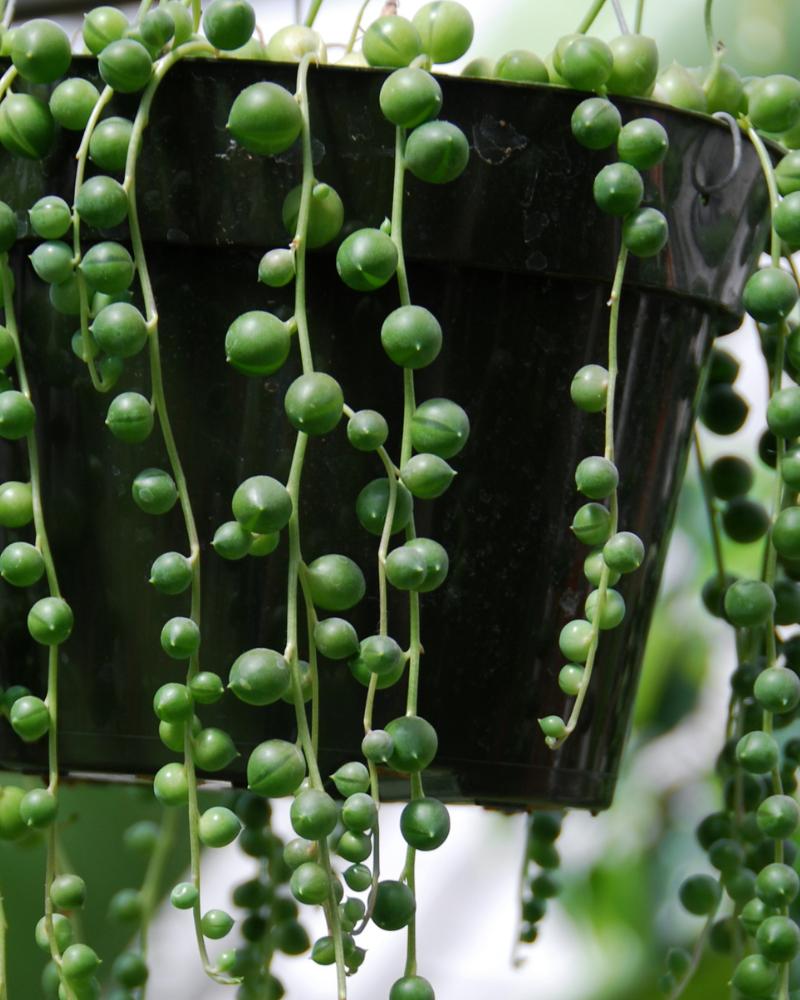
The string of pearls is a great choice for a joyful, fresh, small draping indoor plant with a spring-like personality to hang in your office or home. You can also pair it with a snake plant for a unique decor look.
Scientifically known as Senecio rowleyanus, the string of pearls is a fast-growing plant measuring 30-60cm (12-24 inches) long and tall. The toxic plant is native to South Africa.
Appearance
The thin, trailing branches of the string of pearls form drooping tails of pearl-shaped leaves that wave underneath your hanging basket with a fresh, green color.
They resemble beaded necklaces, except for the fact that you can increase these necklaces through propagation by division, offsets, or cuttings.
Light Requirements
This plant thrives in bright light but can tolerate partial shade, particularly during hot summer afternoons.
Nevertheless, low light levels will lead to stunted growth. On the bright side, you won’t have to prune the plant as often!
Water and Humidity
You don’t have to water the plant quite often since it’s fairly drought-tolerant. You can water it once every two weeks or even once every three weeks during its dormancy. The plant also doesn’t need too much humidity, so your home won’t need any special modifications.
Temperature
The string of pearls flourishes in summer temperatures of around 21℃ (70℉). It also thrives in winter temperatures between 10 and 15℃ (50-60℉).
Soil and Fertilizer
The best option for this plant is a succulent potting mix since it will protect your plant from fungal infections and is well draining.
The string of pearls doesn’t necessarily need to be fertilized. Still, you can apply fish emulsion as the plant is growing.
Final Thoughts
There aren’t as many options for low-light plants compared to plants that need bright light. Nonetheless, quite a few beautiful plants bring their aesthetic qualities and personality to your hanging baskets in dark corridors.
The low-light indoor hanging plants we have highlighted require little maintenance. With the guides in the article, you can easily add vitality to your home.
We hope you find the perfect choice to bring life, color, and vibrancy to your home!
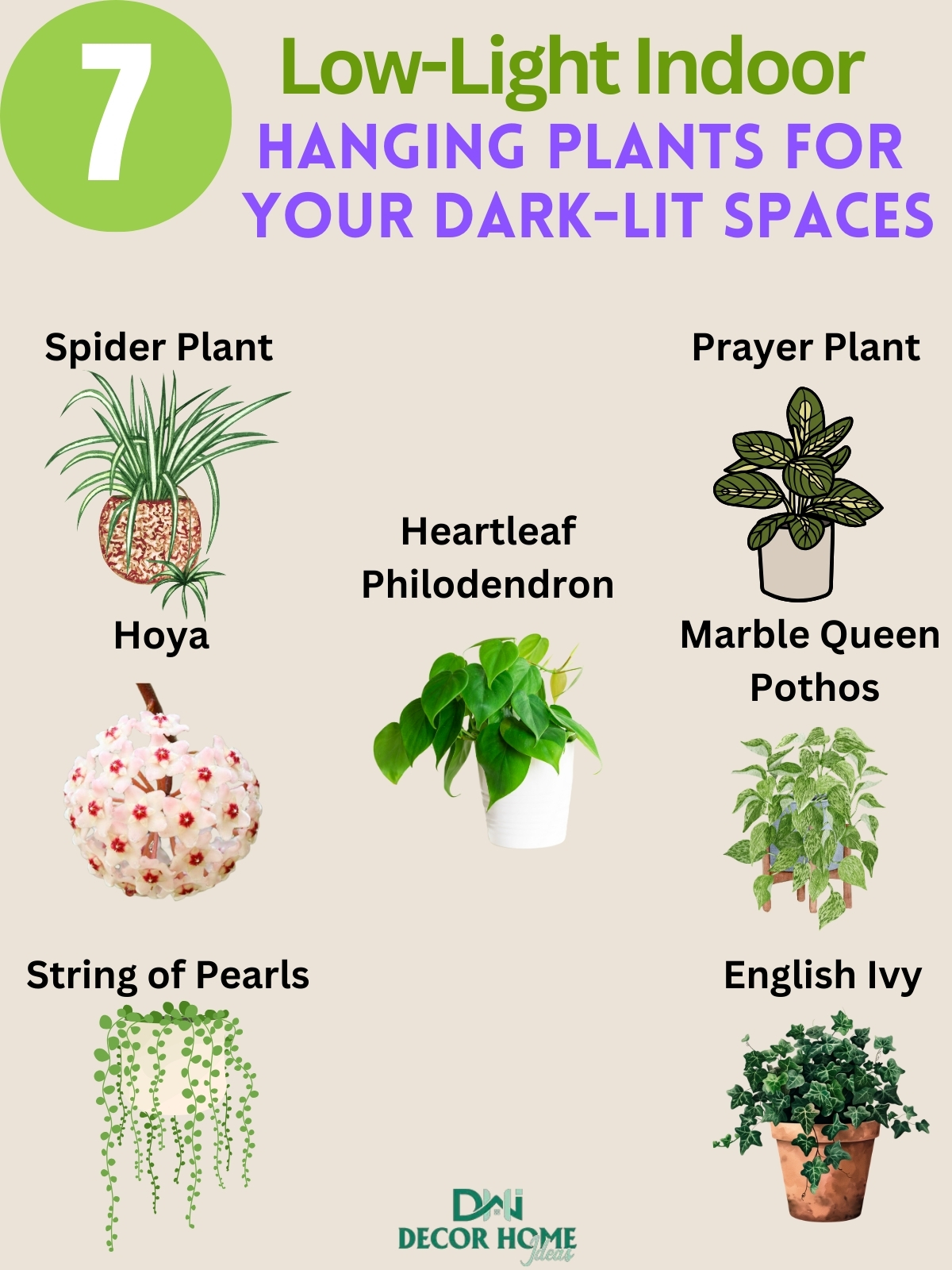
Brighten up dim corners with these stunning low-light hanging plants.
The heartleaf philodendron and marble queen pothos cascade beautifully, while the prayer plant adds unique foliage patterns.
Spider plants and English ivy purify the air, and the string of pearls and hoya bring an elegant, trailing effect.
Perfect for creating a lush, cozy indoor space with minimal light!

